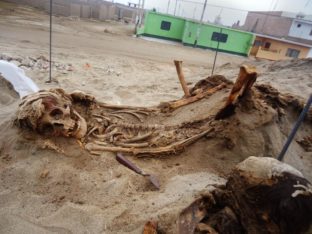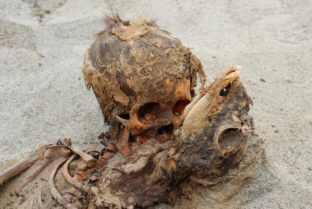Bones dug under the sand; this is what is left of hundreds of children and llamas that have been laying in Peru’s northern coast, forgotten for around 550 years.
The remains of more than 140 children and 200 llamas were found on a cliff in the north-west coast of Trujillo, the third largest city in Peru; the site, Huanchaquito-Las Llamas, had already become known in 2011 for similar discoveries. Since then, excavations have uncovered this massive number of victims, which were, accordingly, all buried within the same event approximately in1450 AD, dug facing the Pacific ocean.

The children, whose ages range from five to 14, with the majority of them between eight and 12, have only had the young llamas, fellow sacrificial victims, as company during their eternal youth. They are said to have belonged to different ethnic groups and regions of the pre-Colombian Chimù Empire.
The bodies present signs of cuts in several bones, including the sternum, and damaging of ribs – possibly to remove their heart. Traces of red pigment have also been found on the children’s skulls. John Verano, one of the lead researchers, has defined this as “a ritual killing,” “very systematic”; he also toldthe National Geographic that “I, for one, never expected it, and I don’t think anyone else would have, either”, since this discovery is unprecedented in the Americas and, most probably, in the whole world.
According to bioarcheologist Haagen Klaus, the children were sacrificed when adult rituals were not proving effective in lessening the disrupting effects of El Niño. This is an extreme weather condition characterized by unusually warm and nutrient-poor sea water that can cause heavy rain in South America. He claims that “people sacrifice that which is of most and greatest value to them” and that, for this reason, the civilization needed a new type of sacrificial victim. We are now presented with a new perspective on human sacrifices: desperate populations which attempt a negotiation with supernatural forces.

The research team is led by Verano, of Tulane Univeristy, and Gabriel Prieto of the Universidad Nacional de Trujillo; they are working together with the National Geographic to reconstruct the lives of the victims and find any additional evidence around the site of Las Llamas. Preliminary analysis made a start by suggesting that both boys and girls were victims, although it is hard to determine from skeletal remains given the young age.
This discovery is certainly a turning point for archeologists and historians, since it represents the largest sacrifice site which has ever been discovered; its detailed analysis will hopefully bring new knowledge to the world of ancient civilizations and the reasons behind these apparently barbaric rituals.
Photo: National Geographic a


